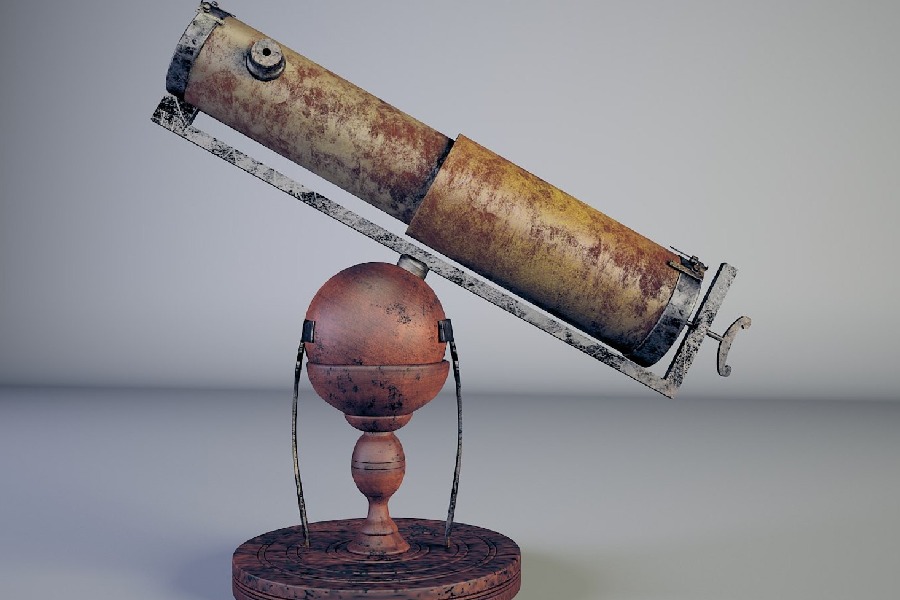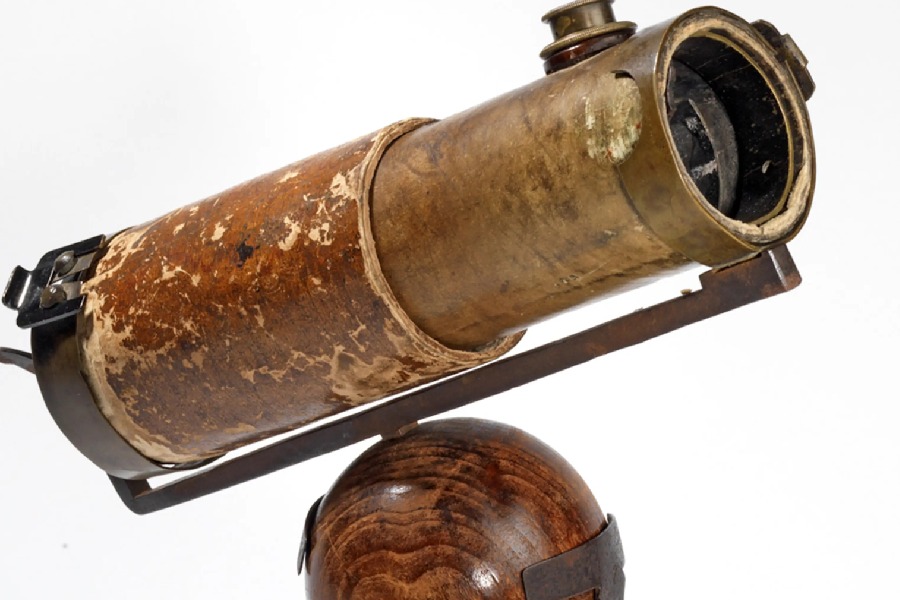When you peer into the night sky, how clearly can your unaided eyes discern details of planets and stars overhead? Humans have gazed curiously about the heavens since antiquity. For that reason, many invented different types of telescopes for Earth-bound observations, but one that struck the attention of many was the Newtonian telescope. So, what is a Newtonian telescope, and how does it work? Discover the mechanics behind this type of optical telescope and its constituent components.
This article explains key principles in optics and wave physics that enabled 17th-century pioneering scientist Sir Isaac Newton to conceive his innovative reflective model. We will briefly recap the relevant background on the refractive telescopes that preceded it during the Scientific Revolution.

What Is a Newtonian Telescope?
A Newtonian telescope is a type of telescope designed by Sir Isaac Newton that uses a curved mirror to gather and reflect light instead of a lens like in some other telescopes.
This curved mirror, called a parabolic mirror, captures and focuses light to create an image. The eyepiece is located at the side of the telescope, allowing for easy viewing.
Newtonian telescopes are popular for their simplicity and cost-effectiveness, making them a favorite among backyard skywatchers to observe celestial objects like stars, planets, and galaxies.
Newtonian Optical Design
Newtonian telescopes employ a spherical or parabolic primary mirror at the bottom of the optical tube assembly. The mirror’s concave shape collects and focuses incoming light from celestial objects.
A small flat secondary mirror near the top reflects the converging light at a 90-degree angle into the eyepiece mounted partway up the tube. This avoids obstructing incoming light paths. It also places the eyepiece in a convenient viewing location on the side of the instrument.
Characteristics of the Newtonian configuration
Newtonian telescopes are designed with a parabolic main mirror positioned at the objective end of the tube. In addition, a small, angled, flat mirror is placed closer to the top.
This flat mirror serves the function of directing the focused light sideways to an eyepiece, which is positioned partway up the tube. This configuration ensures safe and convenient viewing for the observer’s eye.
Making Newtonian telescopes a popular choice among astronomers for their effective and user-friendly design. Locating the eyepiece out the side maintains full aperture light collection through an unobstructed tube.
Primary mirror
The primary mirror uses a precisely shaped parabolic curve to concentrate and converge incident light to a focal point. Typical amateur Newtonian scopes have primaries spanning 3 to 18 inches across. Their focal ratios lie between f/4 and f/8, with low f-numbers affording the brightest wide-field images.
Secondary mirror
The small secondary mirror is mounted inside partway up the telescope tube on a diagonal quartz or plastic rod called a spider. It has an angled front surface oriented to intercept light from the primary mirror and reflect it 90 degrees into the eyepiece. The secondary is made flat so it does not refocus light.
Eyepiece location
In a Newtonian telescope, the eyepiece is positioned partway up the main tube body. This location is specifically chosen to coincide with where emerging light rays converge tightly at the prime focal plane.
This convergence occurs after the light has bounced from the flat diagonal secondary mirror. The design ensures that the eyepiece is strategically placed for optimal observation.
The design allows astronomers to conveniently view the focused and magnified images captured by the telescope. This allows comfortable straight-through eyepiece viewing without uncomfortable body contortions.
Advantages and Disadvantages
Newtonian telescopes offer superb brightness at low cost but need periodic alignments. Key advantages include inexpensive production and excellent light gathering, giving crisp, luminous images. The open tube avoids obstructions, maximizing illumination.
However, the exposed optics are vulnerable to ambient temperature gradients that can degrade resolution. Also, vibrations cause gradual mirror misalignments needing adjustment to maintain peak focus. The secondary mirror mount, too, obstructs a small percentage of incoming light.

Light Path in a Newtonian Telescope
Light from an astronomical object, like a star, enters the open optical tube. It travels straight down the empty barrel to the concave spherical or parabolic primary mirror at the base. This large main mirror sits in a mount angled to aim its reflective surface upwards inside the cylinder.
Hitting the spherical mirror face, incoming photons concentrate and rebound, converging due to the curved shape. They form a diminished, inverted real image midway back up the tube at what is termed the primary focal plane of the system.
Innovative use of secondary mirror
After reflecting tightly off the primary mirror, light needs redirecting sideways to avoid observers needing to peer down the assembly. That’s why Newton placed a small flat pivot table square secondary mirror part way up the tube.
Mounted at a 45-degree angle, it intercepts concentrated light from the primary and then reflects beams 90 degrees into an eyepiece. The flat shape prevents additional focusing of emerging beams. This simplifies optical design while achieving adequate image brightness.
Types of Newtonian Telescopes
Traditional Newtonian telescopes with a flat secondary mirror
The traditional Newtonian telescope has a parabolic primary mirror at the bottom of a tube. A small, flat secondary mirror is mounted partway up the tube at a 45-degree angle. This design was first created by Isaac Newton in the 17th century.
Light enters the open end of the tube and reflects off the parabolic primary mirror. It is brought to a focus below the primary mirror. The angled secondary mirror intercepts the converging light. It reflects the light at a 90-degree angle out the side of the tube.
The Newtonian design provides good image brightness and contrast. It is mechanically simple and relatively easy to construct. The optics are large and more affordable compared to refractors.
Truss-tube and collapsible models
Truss tube Newtonian telescopes use a lattice framework to support the primary mirror instead of a solid tube, which makes the telescope lighter and easier to move. The open truss does not obstruct airflow, preventing image distortion from tube currents.
Collapsible Newtonian telescopes have a primary mirror mounted on a framework that can fold up into a compact shape. This allows for increased portability. The secondary mirror and eyepiece tube often detach as well.
Other Newtonian variants include telescopes with tilted primaries and telescopes with prism diagonals. These modify the optical path or balance of the telescope.
Catadioptric telescopes with Newtonian features
Catadioptric telescopes combine mirror and lens elements. The Schmidt-Newtonian has a spherical primary mirror paired with a correcting lens.
The spherical mirror is easier to manufacture than a parabolic mirror. The lens corrects for spherical aberration. This makes large, affordable telescopes possible.
Light reflects off the spherical primary up to a secondary mirror. It is then directed through a correcting lens element to the eyepiece. The lens fixes the defects from the spherical mirror.
Maintenance and Collimation
Collimation is the process of aligning the mirrors in a Newtonian telescope to ensure they are positioned to reflect light into the eyepiece properly.
Basic collimation involves adjusting the tilt of the primary mirror so that a reflected image of the secondary mirror is centered, then adjusting the secondary mirror so that a reflection of the primary is centered.
Proper alignment maximizes image quality. Collimation may need minor adjustments due to vibration, transport, or temperature changes. Useful tools for collimation include collimation caps, Cheshire eyepieces, and laser collimators.
These allow the user to center reflections during adjustment. Tilting screws on mirror cells allow precision adjustments. Mirror locks can be loosened or tightened as needed. Some telescopes have adjustment knobs rather than screws.
Conclusion
We hope this has helped demystify Newtonian telescopes and shed light on their key components like parabolic mirrors, flat diagonal secondaries, and collapsible or catadioptric variants.
As one of the most popular and affordable reflector telescope designs, Newtonians opened up the cosmos for countless amateur astronomers. With proper maintenance and collimation, these telescopes can provide years of spectacular cosmic viewing.
Their simple but elegant optical design is a testament to Isaac Newton’s genius. By understanding what is a Newtonian telescope, you can better appreciate its capabilities and history. You are now equipped to explore the universe through your own Newtonian telescope. We hope this guide has illuminated the workings of these remarkable stargazing tools.
